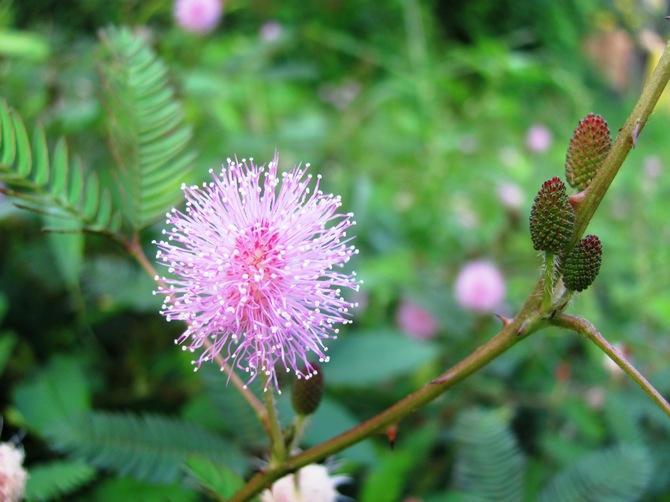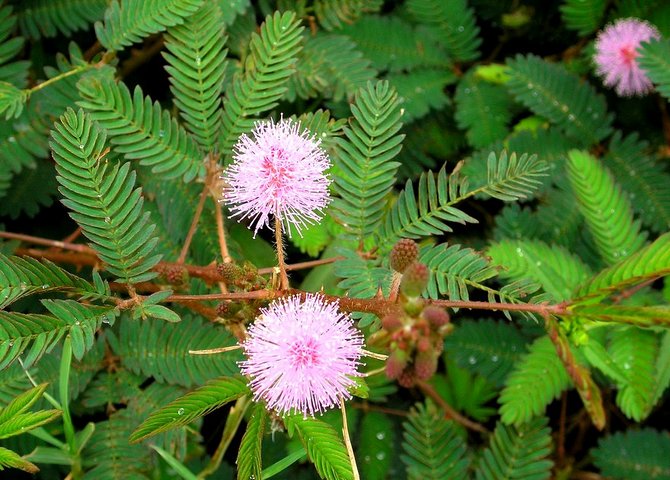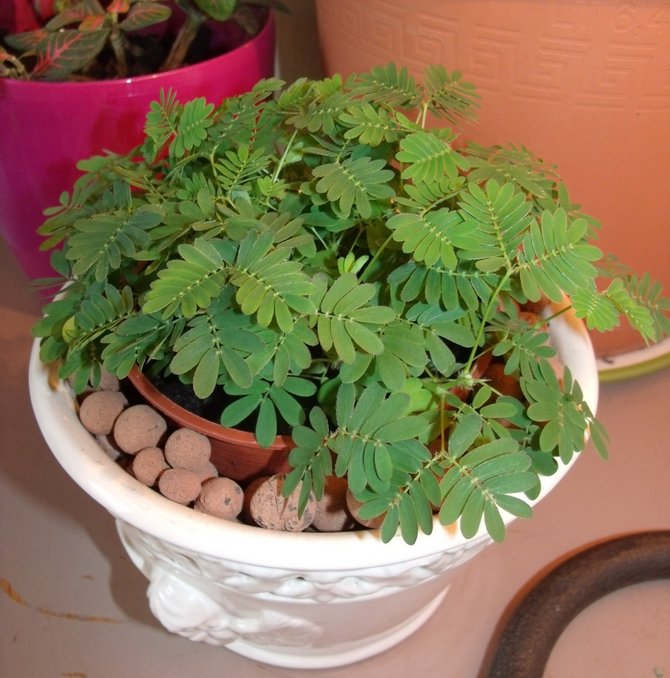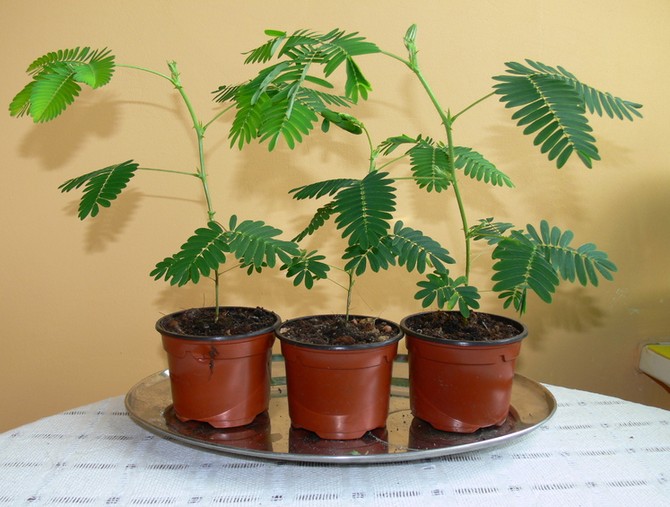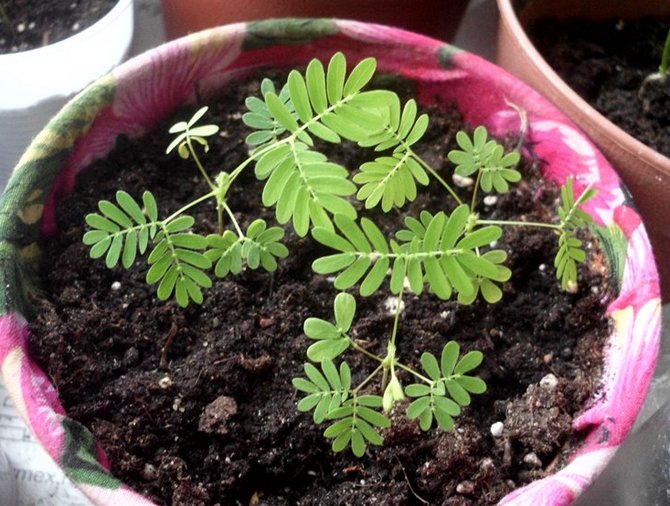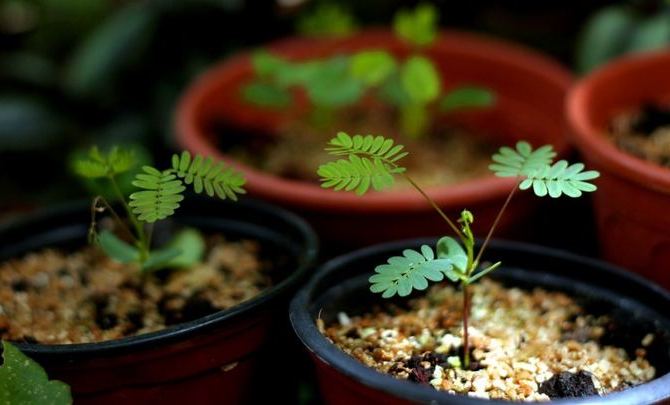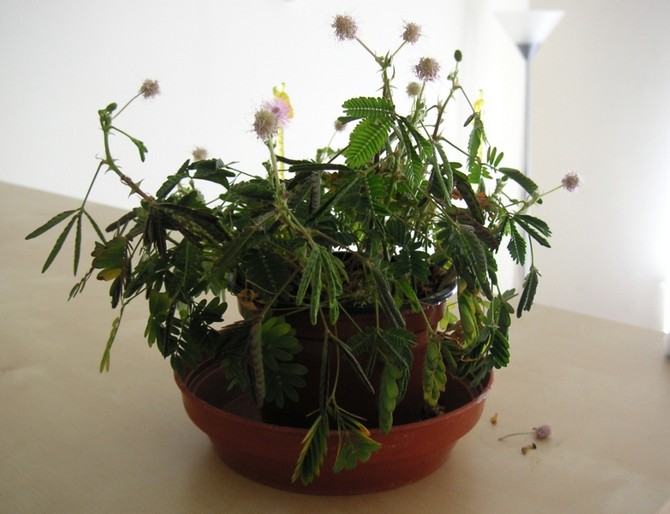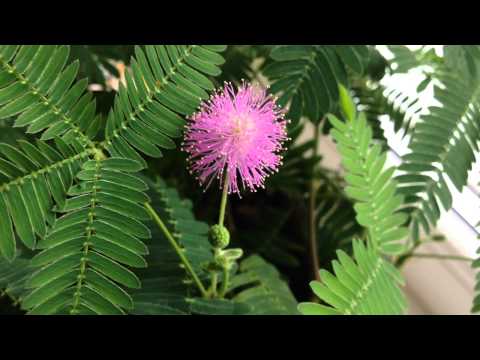Shy mimosa is a very delicate and fragile flower, a real princess who needs careful care. This plant is very much appreciated by true flower growers. The plant belongs to annuals, in indoor conditions it reaches a height of 30-40 cm, and in its natural habitat up to one and a half meters. It has very delicate leaves. Mimosa is native to the tropical climates of America, Africa and Asia. A representative of the mimosa family, with total counts it includes from 300 to 450 species.
Description of the flower mimosa bashful
The plant is a small shrub with small spherical flowers, the leaves of which are similar in appearance to those of a fern. Its flowers resemble dandelion balls, only lilac in color. Such balls bloom up to four months. It is a perennial plant in its habitat, but cultivated mimosa dies in winter..
Mimosa leaves curl up from any external stimulus, hence its name – “bashful”. An irritant can be any touch, light wind or temperature change..
The flower lives according to its own rhythm, similar to the rhythm of a person: sleep and wakefulness. Every 22 hours, mimosa leaves folding, which, by the way, does not depend in any way on the time of day..
Such a reaction to the world around us gives rise to many flower growers to think that it seems to be alive. This property attracts attention. Curled leaves restore their original position after half an hour.
Caring for bashful mimosa at home
One would assume that the bashful mimosa is very capricious to the conditions of caring for her. But in fact, it is not so difficult to maintain it. All that is required is to create the conditions of her native tropical habitat, and then the mimosa will bloom to the delight of the grower..
Location and lighting
The plant is very light-loving and is not afraid of direct rays. At mid-latitudes, it should be placed from the south. In a hotter environment, the southeast will suit her. In extreme cases, it can be placed from the west or east by the window. If in hot climates the plant is in the south, then it is necessary to provide the mimosa with a small shade for several hours..
If mimosa was purchased in a rainy period or in constantly cloudy weather, then when clear days come, getting used to the light should be gradual.
It should be noted that bashful mimosa should be kept at a height inaccessible to small children. The fact that a flower folds leaves under any stimulus can be perceived by them as a game. The plant spends a certain amount of energy on folding, so frequent touching can cause it to dry out..
Important! Adverse factors for mimosa are smoke, both cigarette smoke, and smoke that forms when cooking food, drafts are also not recommended.
Temperature
From the beginning of spring to October, there is a period of intense growth and vegetation. The most optimal temperature regime for mimosa at this time is approximately 20-24 degrees. The winter period takes place at a temperature of 16-18 degrees.
Air humidity
It is necessary to ensure a high level of humidity, approximately 70% or more. How can this be done? This can be done by spraying (by no means on the plant), a container, or a tray of water. The pallet must be positioned so that it does not touch the mimosa pot.
Watering
During the 8-month flowering period, from March to October, you need to water the plant every two days, in the morning or evening. A dry top layer of the substrate will serve as a clue. In winter, watering is carried out so that the soil in the pot is constantly moistened. Water must be used purified, and so that it is not hard.
Soil and fertilizers
The flower feels good in light soil, which allows air and water to pass through. A mixture of turf, sand and peat in equal proportions works best. Using expanded clay will provide the drainage that the bashful mimosa needs.
During the growing season, twice a month, you need to feed the plant. It is enough to use common fertilizers for flowering indoor plants. Dilute the resulting solution by half.
Plant transplant
Shy mimosa is grown as an annual flower, so there is no need to transplant it. But if there is still such a need, then the transplant must be carried out carefully, without spraying a lump of earth, but transplanting it together with all the sod into another pot.
Pollination
The process is used to grow mimosa seeds. As you know, pollination in the natural environment occurs with the help of wind or insects. At home, pollination can be done with the help of a gentle transfer of pollen with a thin soft brush, or you can make the mimosa flowers lightly touch each other.
Reproduction of bashful mimosa
As already mentioned, mimosa is an annual plant, therefore, in order for a flower to grow in you for more than one season, you need to reproduce it every year. There are two ways: using seeds and cuttings.
Seed propagation
As for the seeds, they can be grown at home or purchased from the store. At home, the mimosa fruit is a small pod that contains from 6 to 10 seeds. The fruit can be picked when it is completely dry. They are harvested for the winter and stored in the refrigerator. March is the time for boarding. They are opened and soaked in water at room temperature for about half an hour..
It is advisable to purchase special soil for planting. Indeed, ordinary turf can contain bacteria that prevent the germination of the plant..
The pot should be small, it needs to be equipped with drainage. The bottom is filled with expanded clay, then the soil itself is placed. It should be wet. Next, seeds are placed on its surface and sprinkled with a loose layer (about 1 centimeter). The pot is wrapped in a protective film, creating a greenhouse effect, and placed in a warm place.
It is imperative to maintain a constant temperature of 25-30 degrees and humidity. The pot is ventilated by removing the film from time to time. Watering is carried out by spraying.
Seed rise usually occurs 20-25 days after planting. After that, the mimosa is exposed to the light, but not under direct rays, and again the temperature is maintained at no lower than 24 degrees. When a plant has 3 leaves, then it can be transplanted into a separate pot, while protecting the fragile roots. It should be remembered that young shoots should not be exposed directly to the sun’s rays..
Propagation by cuttings
The cuttings method has many nuances and low efficiency, so it was practically abandoned. Although it is possible to do this, mainly in the aquatic environment or in peat.
Care problems, diseases and pests
Among the possible problems with the content of bashful mimosa, the following should be noted:
- The leaves of the plant curl up due to the presence of smoke in the room. As mentioned earlier, this is undesirable for a flower..
- If you notice that the leaves acquire a yellow tint and become lethargic, and sometimes completely fall off, then most likely the plant suffers from a lack of moisture. It is necessary either to humidify the room, or to water the flower more often..
- There is the opposite problem: the leaves are not opened at all. This happens if the plant has received too much moisture, or the appropriate temperature regime is not observed in the room..
- The stems take on a more elongated shape. This signals that the mimosa lacks light. The solution to the problem can be to move the flower to a lighter corner of the room, or to compensate for the lack of sunlight with artificial lighting..
- The mimosa does not have a flowering period. This indicates an extremely low temperature for a plant – less than 16-18 degrees..
- If you observe a slowdown in the growth of a flower, or the leaves take on bizarre shapes, then this means that the plant has been struck by a disease. It usually develops from spider mites or aphids.
Important! Finally, it should be noted that people who are allergic to pollen, keeping bashful mimosa at home is dangerous to health..

